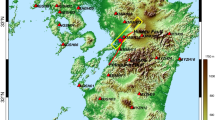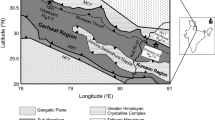Abstract
Nepal has experienced several earthquakes. However, there are only a few time history records of these events. In the last 100 years, the country has witnessed two major earthquakes in 1934 and 2015: the 1934 Nepal–Bihar earthquake and the 2015 Gorkha earthquake. This study aims to simulate the 1934 Nepal–Bihar earthquake in Kathmandu using a deterministic approach. The maximum peak ground acceleration (PGA), response spectrum, Fourier spectrum, predominant period, and mean time period of the simulated earthquake were provided. The validity of the simulation approach was verified by comparing the ground motion parameters of the simulated 2015 Gorkha earthquake with those of the recorded time history. The maximum PGA of the simulated 1934 Nepal–Bihar earthquake in Kathmandu was 0.273 g, which is comparable to the value obtained from the intensity–PGA relationship. The significant duration of earthquakes in Nepal was also compared to that of the other subduction zone earthquakes. It was found that the earthquakes in Nepal lasted longer.











Similar content being viewed by others
Data availability
If authors receive a request for access to data utilized in research, they will make the data available.
References
Ambraseys NN, Douglas J (2004) Magnitude calibration of north Indian earthquakes. Geophys J Int 159:165–206. https://doi.org/10.1111/j.1365-246X.2004.02323.x
Basu J, Podili B, Raghukanth STG, Srinagesh D (2022) Ground motion parameters for the 2015 Nepal earthquake and its aftershocks. Nat Hazards. https://doi.org/10.1007/s11069-022-05755-4
BECA (1993) Seismic hazard map** and risk assessment for Nepal. UNDP/UNCHS (Habitat) Subproject Nep/088/054/21.03. Ministry of Housing and Physical Planning, His Majesty’s Government of Nepal, Kathmandu
Bhattarai GK, Chamlagain D, Rajaure S (2011) Seismic hazard assessment of eastern Nepal using 1934 and 1988 earthquakes. J Nepal Geol Soc 42:85–93. https://doi.org/10.3126/jngs.v42i0.31453
Bilham R (2019) Himalayan earthquakes: A review of historical seismicity and early 21st century slip potential. Geol Soc Spec Publ 483:423–482. https://doi.org/10.1144/SP483.16
Bolt BA (1973) Duration of strong ground motion. In: World conference on earthquake engineering, Rome, pp 1304–1315
Boore DM (2003) Simulation of ground motion using the stochastic method. Pure Appl Geophys 160:635–676
Camacho JRG, Beltrán FV, Tolentino D, Lopez AG (2023) Structural reliability of buildings subjected to simulated ground motions using a novel probabilistic approach. In: 14th international conference on applications of statistics and probability in civil engineering, ICASP14. Dublin, Ireland, pp 9–13
CDPS (2016) Highlights from Nepal earthquake 2015: a socio-demographic impact study (with reference to the 14 most affected districts). Kathmandu
Chaulagain H, Rodrigues H, Varum H et al (2017) Generation of spectrum-compatible acceleration time history for Nepal. C R Geosci 349:198–201. https://doi.org/10.1016/j.crte.2017.07.001
Chen G, Zhu Z, Hu J (2021) Simulation of response spectrum-compatible ground motions using wavelet-based multi-resolution analysis. Measur Control 54:641–646. https://doi.org/10.1177/00202940211013057
Dang P, Cui J, Ma W, Li Y (2023) Simulation of the 2022 Mw 6.6 Luding, China, earthquake by a stochastic finite-fault model with a nonstationary phase. Soil Dyn Earthq Eng 172:108035. https://doi.org/10.1016/j.soildyn.2023.108035
Dang P, Wang C, Qi W, Li Y (2022) An updated stochastic finite fault modeling: application to the Mw 6.0 earthquake in Jiashi, China. Soil Dyn Earthq Eng 162:107450. https://doi.org/10.1016/j.soildyn.2022.107450
Ding Y, Xu Y, Ding S (2023) A stochastic earthquake ground motion database and its application in seismic analysis of an RC frame-shear wall structure. Buildings 13:1637. https://doi.org/10.3390/buildings13071637
Government of Nepal (2015) Nepal Earthquake 2015—post disaster needs assessment. Vol. B: Sector reports. 20
Gregor NJ, Silva WJ, Wong IG, Youngs RR (2002) Ground-motion attenuation relationships for Cascadia subduction zone megathrust earthquakes based on a stochastic finite-fault model. Bull Seismol Soc Am 92:1923–1932. https://doi.org/10.1785/0120000260
Gutenberg B, Richter CF (1942) Earthquake magnitude, intensity, energy, and acceleration. Bull Seismol Soc Am 32:163–191
Jennings PC, Housner GW, Tsai NC (1968) Simulated earthquake motions. Pasadena, CA
Kanno T, Narita A, Morikawa N et al (2006) A new attenuation relation for strong ground motion in Japan based on recorded data. Bull Seismol Soc Am 96:879–897. https://doi.org/10.1785/0120050138
Kawashima K, Aizawa K, Takashashi K (1984) Attenuation of peak ground motion and absolute acceleration response spectra. In: Proceedings of 8th WCEE. San-Franscisco, USA
Kempton JJ, Stewart JP (2006) Prediction equations for significant duration of earthquake ground motions considering site and near-source effects. Earthq Spectra 22:985–1013. https://doi.org/10.1193/1.2358175
Kobayashi T, Morishita Y, Yarai H (2015) Detailed crustal deformation and fault rupture of the 2015 Gorkha earthquake, Nepal, revealed from ScanSAR-based interferograms of ALOS-2. Earth Planets Space 67:1–13. https://doi.org/10.1186/s40623-015-0359-z
Levy S, Wilkinson JPD (1975) Generation of artificial time histories rich in all frequencies from given response spectra. NuclEng Des 38:241–251
Maskey PN, Mishra HK (2005) Selection of attenuation laws for estimation of seismic input in Nepal. J Inst Eng 5:75–85
Mugnier JL, Huyghe P, Gajurel AP et al (2011) Seismites in the Kathmandu basin and seismic hazard in central himalaya. Tectonophysics 509:33–49. https://doi.org/10.1016/j.tecto.2011.05.012
Nath SK, Thingbaijam KKS (2011) Peak ground motion predictions in India: an appraisal for rock sites. J Seismol 15:295–315. https://doi.org/10.1007/s10950-010-9224-5
Ohsaki Y (1994) Introductory book for spectral analysis of earthquakes motion. Kajima Institute of Publishing Co. Ltd., Tokyo
Panta MR (2002) A step towards a historical seismicity of Nepal. Adarsa 2:30–35
Parajuli HR, Ghimire P (2018) Strong motion simulation for Kathmandu by stochastic method. Int J Sci Res Publ 8:41–45. https://doi.org/10.29322/ijsrp.8.6.2018.p7808
Parajuli HR, Kiyono J, Ono Y, Tsutsumiuchi T (2008) Design earthquake ground motions from probabilistic response spectra: case study of Nepal. J JAEE 8:16–28. https://doi.org/10.5610/jaee.8.4_16
Parajuli HR, Shrestha RK (2018) Generation of synthetic ground motion. J Geol Resour Eng 6:105–111. https://doi.org/10.17265/2328-2193/2018.03.002
Rajaram C, Patnala NV, Ramancharla PK (2020) Estimation of seismic hazard for Kathmandu, Nepal and adjacent regions. In: The 17th world conference on earthquake engineering, Sendai, Japan
Rana BS (1935) Great Nepal earthquake 1934. Third. Sahayogi Press, Tripureshwor (in Nepali)
Rezaeian S, Kiureghian A (2008) A stochastic ground motion model with separable temporal and spectral nonstationarities. Earthq Eng Struct Dyn 37:1565–1584. https://doi.org/10.1002/eqe.831
Rezaeian S, Kiureghian A (2012) Simulation of orthogonal horizontal ground motion components for specified earthquake and site characteristics. Earthq Eng Struct Dyn 41:335–353. https://doi.org/10.1002/eqe.1132
Rizza M, Bollinger L, Sapkota S et al (2019) Post earthquake aggradation processes to hide surface ruptures in thrust Systems: The M8.3, 1934, Bihar-Nepal earthquake ruptures at Charnath Khola (Eastern Nepal). J Geophys Res Solid Earth 124:9182–9207. https://doi.org/10.1029/2018JB016376ï
Sakai H (2001) Stratigraphic division and sedimentary facies of the Kathmandu basin group, central Nepal. J Nepal Geol Soc 25:19–32
Sanchez LGA, de Iñárritu PG, Q, Šipčić N, et al (2023) Hazard-consistent simulated earthquake ground motions for PBEE applications on stiff soil and rock sites. Earthq Eng Struct Dyn 52:4900–4918. https://doi.org/10.1002/eqe.3987
Sapkota SN, Bollinger L, Klinger Y et al (2013) Primary surface ruptures of the great Himalayan earthquakes in 1934 and 1255. Nat Geosci 6:71–76. https://doi.org/10.1038/ngeo1669
Sapkota SN, Bollinger L, Perrier F (2016) Fatality rates of the M w ~8.2, 1934, Bihar–Nepal earthquake and comparison with the April 2015 Gorkha earthquake. Earth Planets Space 68:1–9. https://doi.org/10.1186/s40623-016-0416-2
Sato T, Kiyono J (1989) Estimation of seismic intensity of ground motion during the 21 August 1988 earthquake in the Nepal–India border region. J Nat Dis Sci 11:21–36
Shakya K (2016) Earthquake: Impact on Nepalese economy and women. Lowland Technol Int 18:75–82
Sharma KK, Pallav K, Joshi L, Duggal SK (2016) Slip distribution of 15th January 1934 Bihar Nepal earthquake Mw 8.1. In: International conference on advances in civil and structural engineering. institute of research engineers and doctors, LLC, pp 1–6
Shen W, Yang D, Xu X et al (2022) 3D simulation of ground motion for the 2015 Mw 7.8 Gorkha earthquake, Nepal based on the spectral element method. Nat Hazards 112:2853–2871. https://doi.org/10.1007/s11069-022-05291-1
Subedi M, Acharya IP (2022) Liquefaction hazard assessment and ground failure probability analysis in the Kathmandu Valley of Nepal. Geoenviron Disasters 9:1–17. https://doi.org/10.1186/s40677-021-00203-0
Tavakoli P, Rahami H (2023) Generating synthetic ground motions reaching target spectrum with the optimization approach. Structures 58:105480. https://doi.org/10.1016/j.istruc.2023.105480
Tian P, Sun X, Li X, Wan K (2019) Stochastic simulation of ground motions based on NGA-West2 strong motion records. Earthq Sci 32:115–124. https://doi.org/10.29382/eqs-2019-0115-03
Trifunac MD, Brady AG (1975) A study on the duration of strong earthquake ground motion. Bull Seismol Soc Am V 65:581–626
Ulak N (2016) Nepal’s Earthquake-2015: Its Impact on various Sectors. Gaze J Tour Hosp 7:58–86. https://doi.org/10.3126/gaze.v7i0.15120
USGS (2023) http://earthquake.usgs.gov/earthquakes. Accessed 31 July 2023
Yang L, Fu Z, Wang D (2022) Ground motion time history simulation for seismic response history analysis. Front Earth Sci (lausanne) 10:908498. https://doi.org/10.3389/feart.2022.908498
Youngs RR, Chiou SJ, Silva WJ, Humphrey JR (1997) Strong ground motion prediction equations for subduction zone earthquakes. Seismol Res Lett 68:58–73
Zhao JX, Zhang J, Asano A et al (2006) Attenuation relations of strong ground motion in Japan using site classification based on predominant period. Bull Seismol Soc Am 96(3):898–913. https://doi.org/10.1785/0120050122
Acknowledgements
The National Reconstruction Authority (NRA), which provided information on the 2015 Nepal earthquake's damage, is acknowledged by the writers. The Pulchowk Campus, Department of Civil Engineering, is also to be thanked for its unwavering assistance throughout the research.
Funding
The authors declare that no funds, grants, or other support were received during the preparation of this manuscript.
Author information
Authors and Affiliations
Contributions
All authors contributed to the study conception and design. SG and HRP prepared the materials, collected data, and conducted the analysis. SG wrote the original draft of the manuscript, while the other authors provided feedback on earlier drafts. All the authors have read and approved the final manuscript.
Corresponding author
Ethics declarations
Conflict of interest
The authors have no relevant financial or non-financial interests to disclose.
Additional information
Publisher's Note
Springer Nature remains neutral with regard to jurisdictional claims in published maps and institutional affiliations.
Rights and permissions
Springer Nature or its licensor (e.g. a society or other partner) holds exclusive rights to this article under a publishing agreement with the author(s) or other rightsholder(s); author self-archiving of the accepted manuscript version of this article is solely governed by the terms of such publishing agreement and applicable law.
About this article
Cite this article
Ghimire, S., Parajuli, H.R. & Maskey, P.N. Simulation of the 1934 Nepal–Bihar earthquake in Kathmandu. Nat Hazards 120, 5369–5384 (2024). https://doi.org/10.1007/s11069-023-06400-4
Received:
Accepted:
Published:
Issue Date:
DOI: https://doi.org/10.1007/s11069-023-06400-4




